Practicing the CBSE Sample Papers for Class 12 Applied Mathematics Set 5 allows you to get rid of exam fear and be confident to appear for the exam.
CBSE Sample Papers for Class 12 Applied Mathematics Set 5 with Solutions
Time Allowed: 3 hours
Maximum Marks: 80
General Instructions:
- This question paper contains five sections A, B, C, D and E. Each section is compulsory.
- Section – A carries 20 marks weightage, Section – B carries 10 marks weightage, Section – C carries 18 marks weightage, Section – D carries 20 marks weightage and Section – E carries 3 case-based with total weightage of 12 marks.
- Section -A: It comprises of 20 MCQs of 1 mark each.
- Section – B: It comprises of 5 VSA type questions of 2 marks each.
- Section – C: It comprises of 6 SA type of questions of 3 marks each.
- Section – D: It comprises of 4 LA type of questions of 5 marks each.
- Section – E: It has 3 case studies. Each case study comprises of 3 case-based questions, where 2 VSA type questions are of 1 mark each and 1 SA type question is of 2 marks. Internal choice is provided in 2 marks question in each case-study.
- Internal choice is provided in 2 questions in Section – B, 2 questions in Section – C, 2 questions in Section – D. You have to attempt only one of the alternatives in all such questions.
Section – A
All questions are compulsory. No internal choice is provided in this section
Question 1.
What would be the probability of an event ‘G if H denotes it complement, according to the axioms of probability? [1]
(A) P(G) = \(\frac { 1 }{ P(H) }\)
(B) P(G) = 1 – P(H)
(C) P(G) = 1 + P(H)
(D) P(G) = P(H)
Answer:
(B) P(G) = 1 – P(H)
Explanation: According to the given statement P(G) + P(H) = 1
Question 2.
For a binomial distribution, which of the following is correct? [1]
(A) Mean = Variance
(B) Mean < Variance (C) Mean > Variance
(D) None of these
Answer:
(C) Mean > Variance
Explanation: Let X be a binomial variate with
parameters n and p. then,
Mean = np and Variance = npq
Mean – variance = np – npq
= np(1 – q)
= np2
Mean – variance > 0
[∴ n ∈ N and p > 0 ∴ np2 > 0]
Mean > variance.
Question 3.
If E(x) = 4 and E(z) = 8, then E(z – x) is: [1]
(A) 2
(B) 4
(C) 6
(D) insufficient data
Answer:
(B) 4
Explanation: E(z – x) = E(z) – E(x)
= 8 – 4 = 4
Question 4.
The formula used for annuity A as R[(1 + i)n – 1]/i(1 + i)n used to calculate. [1]
(A) Present value of annuity
(B) Future value of annuity
(C) Sinking value of annuity
(D) Nominal value of annuity
Answer:
(A) Present value of annuity
Question 5.
The present value of the cash inflows is ₹ 70,000 and present value of cash outflows is 95,000, then the net present value is: [1]
(A) 25000
(B) – 25,000
(C) 2,55,000
(D) – 2,55,000
Answer:
(B) – 25,000
Explanation:
Net present value = cash outflows – cash inflows
= ₹ 70,000 – ₹ 95,000
= ₹ – 25,000
![]()
Question 6.
The period of time for which the interest is calculated is called the. [1]
(A) Conversion period
(B) Market period
(C) Investment period
(D) Interest period
Answer:
(A) Conversion period
Explanation: The period of time for which the interest is calculated is called conversion period.
Question 7.
The regular deposits to savings account and periodic payments for retirement funds are considered as. [1]
(A) Marginal payment
(B) Effective Payment
(C) Nominal payment
(D) Annuity
Answer:
(D) Annuity
Explanation: An annuity is a series of payments made at equal intervals. Examples of annuities are regular deposits to a savings account, monthly home mortgage payments, monthly insurance payments and pension payments. Annuities can be classified by the frequency of payment dates.
Question 8.
A and B can cover a 200 m race in 22 seconds and 25 seconds respectively. When A finished the race, the B is at what distance from the fiuìishing line? [1]
(A) 24m
(B) 30m
(C) 48m
(D) 54m
Answer:
(A) 24m
Explanation: Distance covered by B in 25 s
= 200 m
Distance covered by B in 22 s
= (\(\frac { 200 }{ 25 }\) x 22) m
= 176 m
∴ B was at a distance of (200 – 176) m 24 m from the finishing line.
Question 9.
If a ≡ b(mod m), then [1]
(A) (a + c) ≡ (b + c) (mod m)
(B) (a – c) ≡ (b – c) (mod m)
(C) (a ± c) ≡ (b ± c) (mod m)
(D) All of the above
Answer:
(D) All of the above
Explanation: If a b(mod in), then m | (a – b)
or, m [(a ± c) – (b ± c)]
or, a ± c ≡ b ± c(mod m)
![]()
Question 10.
Evaluate: 21 mod 2 = ……….. [1]
(A) 2
(B) 19
(C) 10
(D) 1
Answer:
(D) 1
Explanation: On dividing 21 by 2, we get remainder = 1
Hence, 21 mod 2 = 1.
Question 11.
The order and degree (if defined) of differential equation y”‘ + y2 + ey = 0 are: [1]
(A) 3, 1
(B) 3, not defined
(C) not defined, 3
(D) 1, 3
Answer:
(B) 3, not defined
Explanation: The highest order derivative present is y”’, so its order is 3. Here the term ey’ is not a polynomial in y’, so the degree of the given differential equation is not defined.
Question 12.
If y = Ae5x + Be-5x, then \(\frac{d^2 y}{d x^2}\) is: [1]
(A) 25y
(B) 5y
(C) – 25y
(D) 15y
Answer:
(A) 25y
Explanation: Given, y = Ae5x + Be-5x
∴ y’ = 5Ae5x – 5Be-5x
[Differentiating w.r.t. x]
= y’ = 5(Ae5x – Be-5x)
y” = 5(5Ae5x + 5Be-5x)
[Differentiating again w.r.t. x]
y” = 25(Ae5x + Be-5x)
y” = 25y
or \(\frac{d^2 y}{d x^2}\) = 25y
Question 13.
What is the nature of function f(x) = 7x – 4 on R? [1]
(A) Increasing
(B) Decreasing
(C) Strictly Increasing
(D) Increasing and Decreasing
Answer:
(C) Strictly Increasing
Explanation:
Let x1 and x2 be any two numbers in R.
Then x1 < x2
⇒ 7 x 1 < 7 x 2.
⇒ 7 x 1 – 4 < 7 x 2 – 4.
As f(x1) < f(x2), thus the function f is strictly increasing on R.
![]()
Question 14.

then al + bA + 2A2 equals: [1]
(A) A
(B) – A
(C) abA
(D) None of these
Answer:
(D) None of these
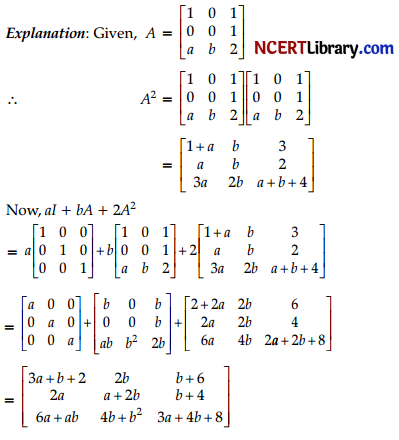
Question 15.
A = [aij ]mxn is a square matrix, if. [1]
(A) m < n (B) m > n
(C) m = n
(D) None of these
Answer:
(C) m = n
Explanation: It is known that a given matrix is said to be a square matrix if the number of rows is equal to the number of columns.
Therefore,
A = [aij ]mxn is a square matrix, if m = n.
Question 16.
If A and B are symmetric matrices of same order, AB – BA is a: [1]
(A) Skew-symmetric matrix
(B) Symmetric matrix
(C) Zero matrix
(D) Identity matrix
Answer:
(A) Skew-symmetric matrix
Explanation: Given that, A and B are symmetric matrices.
⇒ A = A’ and B = B
Now, (AB – BA)’ = (AB)’ – (BA)’ ………(i)
⇒ (AB – BA)’ = B’A – A’B’ [By reversal law]
⇒ (AB – BA)’ = BA – AB [From Eq.(i)]
⇒ (AB – BA)’ = – (AB – BA)
Question 17.
In the theory of time series, shortage of certain consumer goods before the annual budget is due to. [1]
(A) Seasonal Variation
(B) Secular Trend
(C) Irregular Variations
(D) Cyclic Variation
Answer:
(A) Seasonal Variation
Explanation: Seasonal variation is variation in a time series within one year that is repeated more or less regularly. So, shortage of consumer goods before the annual budget is due to seasonal variation.
Question 18.
How many of the following points satisfy the in equality 2x – 3y > – 5? [1]
(1,1),(- 1, 1),(1,- 1),(- 1,- 1),(- 2, 1),(2,- 1),(- 1,2)and(- 2, – 1).
(A) 3
(B) 5
(C) 6
(D) 4
Answer:
(B) 5
Explanation: (1, 1), (1, – 1), (- 1, – 1), (2, – 1) and (- 2, – 1) satisfy the inequality 2x – 3y > – 5.
DIRECTION: For questions 19 and 20, two statements are given – one labelled Assertion(A) and the other labelled
Reason (R). Select the correct answer to these questions from the codes (A), (B), (C) and (D) as given below:
(A) Both assertion (A) and reason (R) are true and reason (R) is the correct explanation of assertion (A).
(B) Both assertion (A) and reason (R) are true and reason (R) is not the correct explanation of assertion (A).
(C) Assertion (A) is true but reason (R) is false.
(D) Assertion (A) is false but reason (R) is true.
![]()
Question 19.
Assertion (A): The mean of X, if X is a Poisson variate satisfying the condition P(4) = P(5) is = 5.
Reason (A): The mean of X, if X is a Poisson variate satisfying the condition P(4) = P(5) is X = 4. [1]
Answer:
Option (C) is correct.
Explanation: Here, x = 4 and 5
![]()
⇒ λ = \(\frac { 4! }{ 5! }\)
⇒ λ = 5
Question 20.
Assertion (A): If m and n are the order and degree, respectively of the differential equation y(\(\frac { dy }{ dx }\))3 + x3 (\(\frac{d^2 y}{d x^2}\) )2 – xy
= sin z, then write the value of ni + n is 4.
Reason (A): Both order and degree of given differential equation are 2. [1]
Answer:
Option (A) is correct.
Explanation: m + n = 4
∵m = 2 (second order derivative)
∴ n = 2
(degree of the highest order derivative)
Section – B
All questions are compulsory. In case of internal choice, attempt any one question only
Question 21.
Vehicles pass through a junction on a busy road at an average rate of 300 per hour. [Given: e-5 = 6.7379 X 10-5] [2]
(a) Find the probability that none passes in a given minute.
(b) What is the expected number passing in two minutes?
Answer:
The average number of cars per minute is:
μ = \(\frac { 300 }{ 60 }\) = 5
![]()
= 6.7379 x 10-3
(b) Expected number each 2 minutes = E(X)
= 5 x 2 = 10
Question 22.
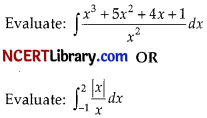 [2]
[2]
Answer:
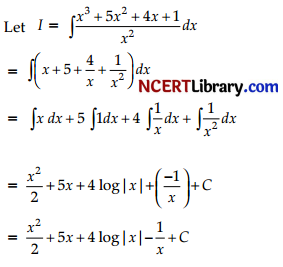
OR
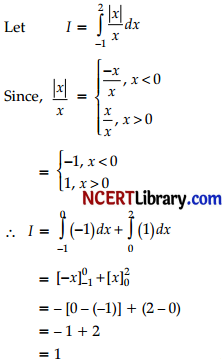
Question 23.
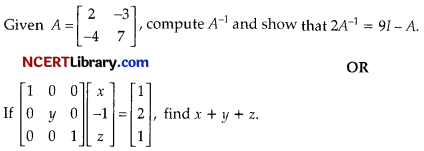 [2]
[2]
Answer:
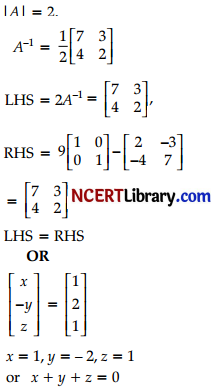
Question 24.
Write down the models of Time Series Analysis.
Answer:
There are two models of time series analysis
(i) Additive model: This model is based on the assumption that the sum of four components is equal to the original value
i.e., 0 = T + C + S + I
where, T= trend, C = cyclical, S = seasonal, I = irregular, 0 = original
(ii) Multiplicative model: In this model four components have a multiplication relationship,, so
0 = T x C x S x I
![]()
Question 25.
Find the students – t for the following variable values in a sample of eight:
– 4, – 2, – 2, 0, 2, 2, 3, 3 taking the mean of the universe to be zero. [2]
Answer:
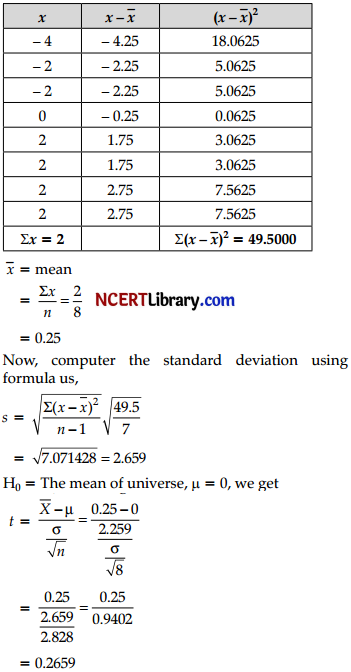
Section – C
All questions are compulsory. In case of Internal choice, attempt any one question only
Question 26.
Ram took a home loan of ₹ 50 lakhs at an 8.50 % interest for a 20 years loan tenure. What would be his EMI ? Given
(1.0070)240 = 5.3342 [3]
Answer:
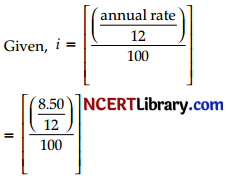
= \(\frac { 0.70833 }{ 100 }\)
= 0.0070
n = 20 x 12 = 240
p = ₹ 50,00,000

= \(\frac { 5.3342 }{ 5.3342 – 1 }\) x 35,000
= \(\frac { 186,697 }{ 4.3342 }\)
= ₹ 43,075.308 ~ ₹ 43,075
Question 27.
A person invested ₹ 15000 in a mutual fund and the value of investment at the time of redemption was ₹ 25000. If CAGR for this investment is 8.88%, then calculate the time period for which the given amount was invested?
[Given log(1 .667) =0.2219 & log(1 .089) = 0.037] [3]
Answer:
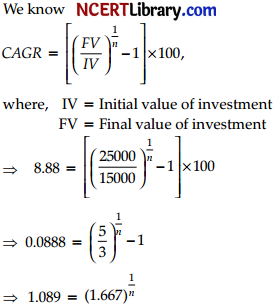
⇒\(\frac { 1 }{ n }\) log (1.667) = log (1.089)
⇒ n (0.037) = 0.2219
⇒ n = 5.99 ≈ 6 years
Question 28.
Two pipes can fill a cistern in 14 hours and 16 hours respectively. The pipes are opened simultaneously and it is found that due to leakage in the bottom it took 32 minutes more to fill the cistern. When the cistern is full, in what time will the leak empty it? [3]
OR
(i) 8 litres are drawn from a cask full of wine and is then filled with water. This operation is performed three more times. The ratio of the quantity of wine now left in cask to that of the water is 16 : 65. How much wine did the cask hold originally?
(ii) Show that graph of the solution 2x – 3 > x – 5 on number line. [3]
Answer:
Fill thecisternby the two pipes in 1 hour = (\(\frac { 1 }{ 14 }\) + \(\frac { 1 }{ 16 }\))
∴Time taken by these pipes to fill the cistern = \(\frac { 15 }{ 112 }\) hours
= 7 h 28 min
Due to leakage, time taken = 7 h 28 min +32 min = 8h
∴Fill the cistern by (two pipes + leak) in 1 hour = \(\frac { 1 }{ 8 }\)
empty the cisternby the leakin 1 hour = (\(\frac { 15 }{ 112 }\) – \(\frac { 1 }{ 8 }\)) = \(\frac { 1 }{ 112 }\)
∴ Leak will empty the full cistern in 112 hours.
OR
(i) Let the quantity of the wine in the cask originally be x litres.
Then, quantity of wine left in cask after 4 operations
= [x ( 1 – \(\frac { 1 }{ 8 }\))4] litres
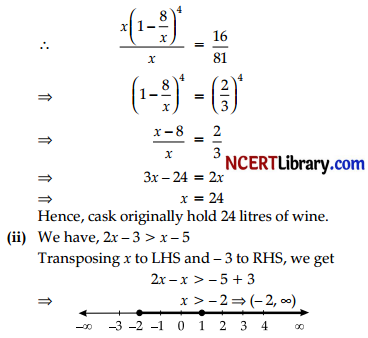
![]()
Question 29.
Calculate four – Yearly moving averages of number of students studying in a higher secondary school in a particular city from the following data. [3]
Answer:
Computation of four – yearly moving averages:
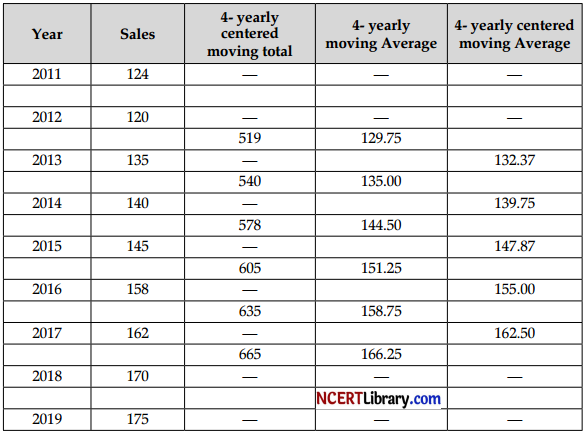
Question 30.
Find the studenrs -t for the following variable values in a sample of eight – 4 – 2 – 2, 0, 2, 2, 3, 3 taking the mean of the universe to be zer0. [3]
OR
A scientist has conducted a one-sample experiment (a) What two parametric procedures are available to her? (b) What is the dedding factor for selecting between them? (c) What are the other assumptions of the t-test? [3]
Answer:

\(\bar{X}\) = mean
= \(\frac { ∑x }{ n }\)
= \(\frac { 2 }{ 8 }\)
= 0.25
Now, compute the standard deviation using formula as,
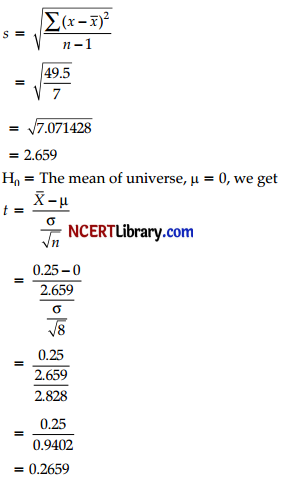
OR
(a) A scientist has conducted a one-sample experiment, two parametric procedures are available here those are
- t – test and
- z – test.
(b) The deciding factor for using z-test is the standard deviation of the raw score population a1 is known. The deciding factor for using t – test is the standard deviation of the raw score population a1 is not known.
(c) The following are the assumptions for one sample f – test:
- We have one random sample of interval or ratio scores.
- The raw score population forms a normal distribution.
- The standard deviation of the raw score population is estimated by computing.
Question 31.
Solve the following LPP graphically:
Maximize Z = 4x + y
Subject to following constraints [3]
x + y ≤ 50
3x + y ≤ 90,
x ≥ 1o
x, y ≥ 0
Answer:
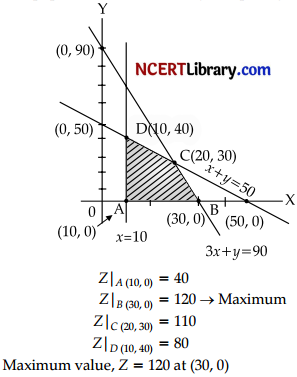
Section – D
All questions are compulsory. In case of internal choice, attempt any one question only
Question 32.
A machine costing ₹ 50,000 is to be replaced at the end of 10 years, when it will have a salvage value of ₹ 5000. In order to provide money at that time for a machine costing the same amount, a sinking fund is set up. If equal payments are placed in the fund at the end of each quarter and the fund earns at the rate of 8% compounded quarterly, then what should each payment be? [Given (1.02)40 = 2,208 ] [5]
Answer:
The amount of sinking fund S at any time is given by

where R = periodic payment,
i = Interest per period,
n = number of payments
S = Cost of machine – Salvage value
= ₹ 5,000 – ₹ 5000 = ₹ 45,000
i = \(\frac { 8% }{ 4 }\) = 0.02
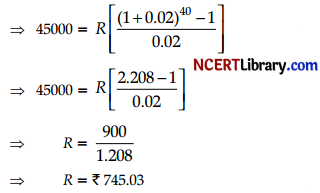
Question 33.
Find the highest power of 6 in ∠245. [5]
Answer:
Since, 6 = 2.3
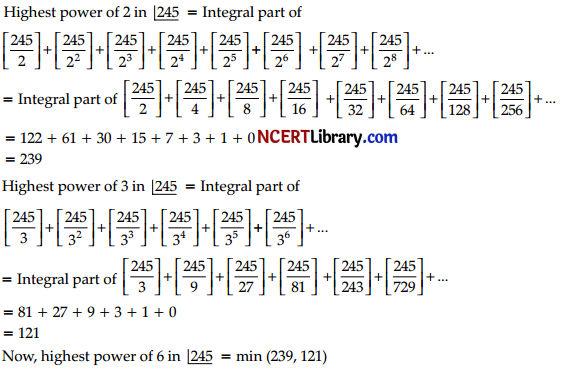
= 121
Hence, highest power of 6 in 245 is 121.
![]()
Question 34.
Show that the surface area of closed cuboid with square base and given volume is minimum when it is a cube.
OR
Suppose the growth of a population is proportional to the number present. If the population of a colony doubles
in 25 days, in how many days will the population become triple? [5]
Answer:
Let the length and breadth be x units (square base), height of cuboid be h unit.
Volume of cuboid (y) = x2h
∴ h = \(\frac { v }{ x^2 }\)
Surface area of cuboid
(s) = 2(x2 + xh + xh)
∴ s = 2x2 + 4 xh
s = 2x2 + 4x x \(\frac { v }{ x^2 }\)
s = 2x2 + 4v\(\frac { 1 }{ x }\)
∴ \(\frac { ds }{ dx }\) = 4x – 4v \(\frac { 1 }{ x^2 }\)
For maximum and minimum surface, \(\frac { ds }{ dx }\) = 0
∴ 4x – 4v.\(\frac { 1 }{ x^2 }\) = 0
4x = \(\frac { 4v }{ x^2 }\)
x3 = v
xx3 = x2h
x = h
Now, \(\frac{d^2 s}{d x^2}\) = 4 + \(\frac { 8v }{ x^3 }\)
At x = h,
\(\frac{d^2 s}{d x^2}\) = 4 + \(\frac { 8v }{ h^3 }\) > 0
∴ Surface area is minimum, when x = h.
i.e., when x = h, it is a cube, surface area will be minimum. x = h
OR
OR
Let P0 be the initial population and P be the
population at any time f.
Given, \(\frac { dP }{ dt }\) ∝ P
\(\frac { dP }{ dt }\) = kP, k is constant
\(\frac { dP }{ dt }\) = k dt
∫\(\frac { dP }{ dt }\) = k ∫dt
log |P| = kt + C
At t = 0, we have P = P0
∴ From eq (i) log |P0| = 0 + C
C = log |P0|
There, eq (i) becomes log P = kt + log P0
log |\(\frac{P}{P_0}\)| = kt
Also, given that P = 2P0 when t = 25 days.
∴ From eq (ii), we have
log |\(\frac{2 P_0}{P_0}\)| = 25k
k = \(\frac { 1 }{ 25 }\) log 2
Put value of k in eq (ii), we get
log |\(\frac{P}{P_0}\)| = (\(\frac { 1 }{ 25 }\)log 2)t …..(iii)
Suppose the population is tripled in t1 days i.e.,
P = 3P0 whent = f1
Put P = 3P0 and t = t1 in eq (ii), we get
log |\(\frac{3 P_0}{P_0}\)| = (\(\frac { 1 }{ 25 }\)log 2)t1
t1 = 25 (\(\frac { log3 }{ log2 }\))days
Hence, population is tripled in 25(\(\frac { log3 }{ log2 }\)) day
= 39.629 days
Question 35.
Using properties of determinants, prove that
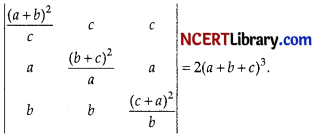
OR
For what values of a and b, the system of equations
2x + ay + 6z = 8
x + 2y + bz = 5
x + y + 3z = 4,
has (i) unique solution (ii) no solution? [5]
Answer:

(i) For unique solution, we must have
D ≠ 0 ⇒ (a – 2)(b – 3) ≠ 0 ⇒ a ≠ 2 or b ≠ 3
(ii) For no solution, we must have D = 0 and at least one of Dx, Dy and Dz is non-zero.
Clearly, b = 3, we have
D = 0 and Dz ≠ 0
Hence, the system has no solution for b = 3.
Section – E
All questions are compulsory. In case of internal choice, attempt any one question only
CASE STUDY – I
Question 36.
A manufacturer produces two Models of bikes-Model X and Model Y. Model X takes a 6 man-hours to make per unit, while Model Y takes 10 man-hours per unit. There is a total of 450 man-hours available per week. Handling and Marketing costs are ₹ 2,000 and ₹ 1,000 per unit for Models X and Y respectively. The total funds available for these purposes are ₹ 80,000 per week. Profits per unit for Models X and Y are ₹ 1000 and ₹ 500, respectively. The feasible region of LPP is shown in the following graph.
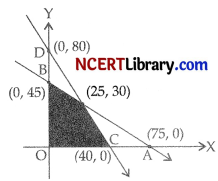
(i) Find the equation of line AB and CD. [1]
(ii) Find the coordinates of point E. [1]
(iii) Write the for L.P.P. for given problem. [2]
OR
How many bikes of model X and model Y should the manu facturer produce so as to yield a maximum profit?
Answer:
(i) From the given graph OA = 75 and OB = 45.
The equation of line AB is \(\frac { x }{ 75 }\) + \(\frac { y }{ 45 }\) = 1
i.e., 3x + 5y = 225
From the given graph OC = 40 and OD = 80.
The equation of line CD is \(\frac { x }{ 40 }\) + \(\frac { y }{ 80 }\) = 1
i.e., 2x + y = 80
(ii) On solving the equations of lines AB and CD, we get the coordinates of point E
i.e., (25, 30).
(iii) Let the manufacturer produces x number of model X and y number of model Y bikes.
The objective function for given LPP is
Z = 1000x + 500y
Model X takes 6 man-hours to make per unit and
model Y takes 10 man-hours to make per unit.
There is total of 450 man-hours available per week.
6x + 10y ≤ 450
3x + 5y ≤ 225
For models X and Y, handling and marketing costs are ₹ 2,000 and ₹ 1,000, respectively, total funds available for these purposes are ₹ 80,000 per week
∴ 2,000x + 1,000y ≤ 80,000
2x + y ≤ 80 ………….(ii)
Also, x ≥ 0,y ≥ 0
Alternate Solution: As (0, 0) lies in the region
3x + 5y ≤ 225 and also (0,0) lies in the region 2x + y ≤ 80,
therefore the constraints for the LPP are:
3x + 5y ≤ 225, 2x + y ≤ 80, x ≥ 0, y ≥ 0
OR
The objective function for given L.PP
From the shaded feasible region, it is dear that
coordinates of corner points are (0, 0), (40, 0), (25, 34)) and (0, 45).
| Corner points | Value of Z = 1000x + 500y |
| (0, 0) | o |
| (40, 0) | 40,000 ← Maximum |
| (25, 30) | 25,000 + 15,000 = 40,000 ← |
| (0, 45) | Maximum |
So, the manufacturer should produce 25 bikes of model X and 30 bikes of model Y to get a maximum profit of ₹ 40,000.
CASE STUDY-II
![]()
Question 37.
The amount of bread (in hundreds of kilograms) X that a certain bakery is able to sell in a day is found to he a numerical valued random phenomenon with a probability function specified by the probability density function f(x), given by
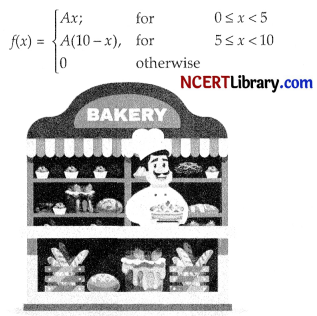
(i) Find the value of A such that f(x) is the probability density function.[1]
(ii) What is the probability that number of kilogram of bread that will be sold tomorrow is more than 500 kgs? [1]
(iii) What is the probability that number of kilograms of bread that will be sold tomorrow is between 250 kgs and 750 kgs? [2]
OR
The probability density function f(x) of a continuous random variable x is given by f(x) = 3x2, O ≤ x ≤ 1 Then, find P(0.2 ≤ x ≤ 0. 5).
Answer:
(i) For f(x) to be the probability density function, we must have
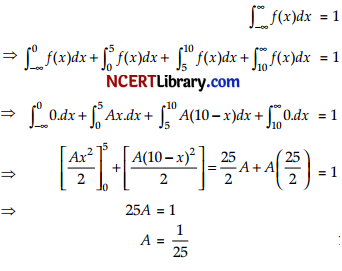
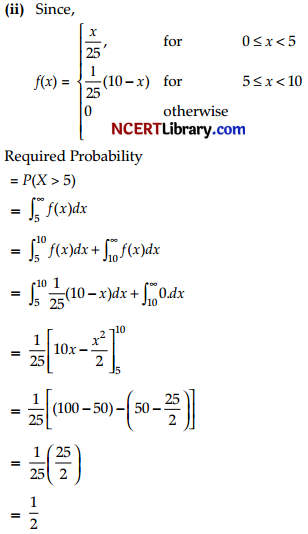
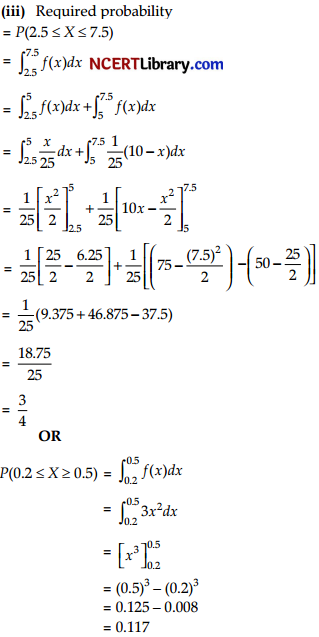
CASE STUDY – III
Question 38.
The market research department oía company recommends manufacture and market a new toy-car. The financial department provides the following cost function (in rupees) C(x) = 7,000 + 2x; 0 ≤ x ≤ 10,000 where ₹ 7,000 is the estimate of fixed costs and ₹ 2 is the estimate of variable cost per toy-car. The estimate of revenue function (in rupees) is R(x) = x(10 – 0.001x); 0 ≤ x ≤ 10,000.
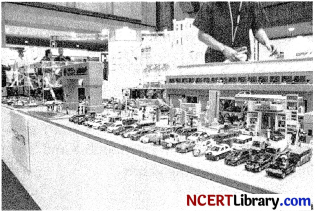
(i) Find the marginal cost function. [1]
(ii) Find the marginal revenue function. [1]
(iii) Find the marginal revenue function at x = 2000, 5000 and 7000. [2]
OR
Find the profit function and marginal profit at x = 1000.
Answer:
(i) The marginal cost is
C(x) = 7000 + 2x
C’(x) = 2
Since 2 is a constant, it cost an additional ₹ 2 to produce one more toy-car at any production level.
(ii) The margina! revenue is
R’(x) = 10 – 0002x.
(iii) For production level of x = 2,000,5000, and 7000, we have R(x) = 10 – 0.002x
R’(2,000) = 6
R(5,000) = 0
R(7,000) = – 4
OR
The profit function is
P(x) = R(x) – C(x)
= – 0.001 x2 + 8x – 7000
The marginal profit function is
P'(x) = – 0.002x + 8.
There fore, P'(1,000) = 6